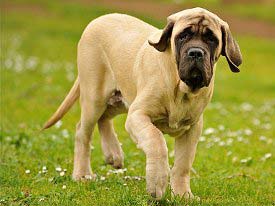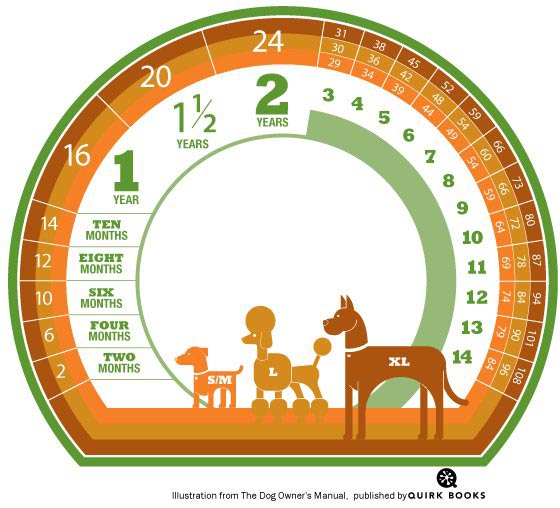|
 Converting dog years to human years takes more than multiplying by 7. Dogs age differently in their early years than in their adult and senior years, and dogs of different sizes age differently. So how do you figure out your dog's age in human years? Converting dog years to human years takes more than multiplying by 7. Dogs age differently in their early years than in their adult and senior years, and dogs of different sizes age differently. So how do you figure out your dog's age in human years?
The first two years are pretty straight-forward. The first year of a dog’s life counts for much more than simply 7 years. In fact, a 1-year-old dog is better compared to a human 14-16 years old. This makes sense when you consider how close they are to their adult size, the fact that their reproductive systems are formed, and their maturity level. It’s also why a one-year-old dog, while sometimes considered an adult, is still high energy and a little naughty at times. (If your year-old dog hasn’t chewed in a while then suddenly destroys something, think of it like teenage rebellion.) By the time your dog reaches his second birthday, he should be full-grown and maybe a little calmer. You could compare a 2-year-old dog to a person in his/her twenties: full height and a little more mature, though perhaps not quite ready to settle down.
The years after this get a little more complicated. Now, we have to consider your dog's age plus his size. Smaller dogs tend to live longer lives than bigger dogs, so each year for a small dog corresponds to fewer human years. Larger dogs tend to start showing signs of age earlier than smaller dogs, with giant breed dogs typically considered to be seniors around age 7. Read More: Senior Dog Health Care
The easiest way to determine your dog’s age in human years is to compare his age and size to the chart below. Here’s how to read the chart:
1) Determine if your dog is small to medium, large, or giant.
2) Find your dog’s actual age in the green numbers on the white background.
3) Then, look at the corresponding numbers on the colored background for your dog’s size.
a. Small to medium dogs: Use the number on the orange background, the ring closest to the center. A small or medium 5-year-old is approximately 39 in human years.
b. Large dogs: Use the number on the gold background. A large 5-year-old is approximately 42 in human years.
c. Giant dogs: Use the number on the brown background. A giant 5-year-old is approximately 45 in human years.

You'll notice that as the years go on, the rate of aging compared to human years changes by size. While 3-year-olds of all sizes have human ages within a 2-year range, just 4 years later at age 7 there's a 10-year gap in relative age. That's how big a role size plays in a dog's "human" age.
If you're trying to compare dog years to human years, this chart will give you a better sense of how to do it than the old wives' tale about 7 years. It's especially helpful to know when your dog earns senior status. Senior dogs need different care than younger dogs, so it’s really important to know when you need to talk to your vet about his changing needs.
You may also like:
How To Get A Puppy To Stop Biting - If your dog's nipping is getting out of control, try these tips.
How Much Do Dogs Sleep? - Another questions whose answer depends on your dog's age.
Photo credit: Claudio Gennari
|